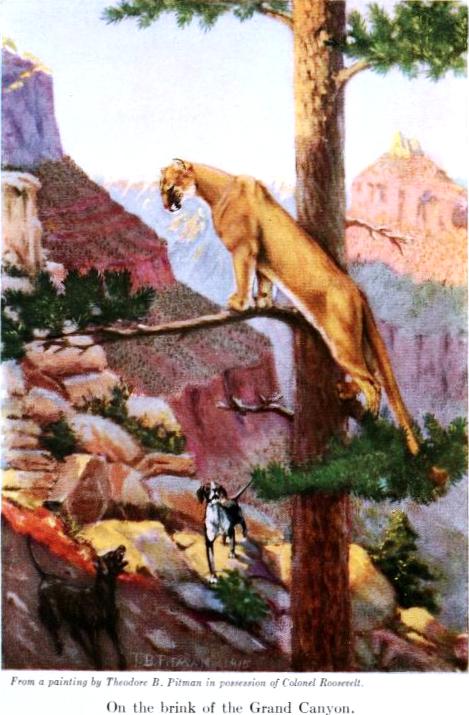A Tribute to America’s Conservation President
Theodore Roosevelt Memorial at the American Museum of Natural History
In 2012, the American Museum of Natural History (AMNH), one of BHL’s founding members, celebrated the grand reopening of the Theodore Roosevelt Memorial. For three years, the Memorial was closed to the public as part of a 37.5 million dollar renovation plan to re-imagine this permanent exhibit. Theodore Roosevelt, America’s Conservation President, was intimately tied to the museum since its founding in 1869. This week’s book of the week selection, A Book-lover’s Holidays in the Open (1916) was written by Teddy and affords readers an intimate glimpse inside the mind of one of America’s most fascinating presidents.
 |
| The murals depict milestones in TR’s life. (Credits: Amal Chen/The Epoch Times) |
The renovation includes a new life-size bronze statue of Theodore Roosevelt and several exhibits charting Roosevelt’s journey from budding naturalist to becoming America’s conservation president. Perhaps, the most exciting for those from the art world is the 2.5 million dollar allocation that went towards the restoration of William Andrew Mackay’s murals of Roosevelt. The murals, recording key moments in the life of Roosevelt greet you at the main entrance and cover a space of over 5,200 feet.
A Book-lover’s Holidays in the Open (1916)
|
Book Frontispiece
|
To continue AMNH’s celebration of Roosevelt, we wanted to highlight a book that they digitized for the BHL. As the title of this week’s book suggests, Theodore Roosevelt liked to read books. Correction. This man LOVED to read books. Many in his personal circle have vouched that “Teedie” read at least one book per day, most often finishing said tome before breakfast. This seemingly ambitious reading schedule made Roosevelt the most well-read president alongside, Thomas Jefferson.
As a young boy, Roosevelt was an asthmatic bookworm often confined to his Manhattan family flat. One can almost see him wistfully longing for the outdoors as he escaped city life in the imaginative world of books. However, it was this deprivation from the natural world that caused him to love the great outdoors all the more. He looked forward to family vacations in upstate New York where he could observe nature’s creatures in all their glory.
As early as age 7, Teddy began to collect specimens and wrote about them in minute detail. He even learned amateur taxidermy around age 12 and began adding specimens to a personal collection that he and his cousins dubbed “Roosevelt’s Natural History Museum.” His father fully supported young Roosevelt’s budding interest, being a nature lover himself. In fact in 1869, Theodore Roosevelt Sr. signed the American Museum of Natural History’s founding charter with other trustees in the parlor of the Roosevelt family home on East 20th Street in New York City. Moreover, the Roosevelt family is deeply connected to AMNH, having served on the Museum’s board for its entire history.
 |
| A young naturalist’s journal. Photo Credits: AMNH |
With A Book-lover’s Holidays in the Open (1916), you get an eclectic mix of stories, personal anecdotes and Roosevelt’s views about conservation in America. Our favorite excerpt from this book, which defies a cursory summary and warrants a fully digested read, illustrates Teddy’s internal transformation from a hunter that appreciated nature to a President who became, arguably history’s most influential conservation policy maker. Admittedly, this chunk of text is quite long but, Teddy’s words are eloquent and if you are hurried at least have a look at the passages in conservation green:
“The westernmost island, we visited was outside the national reservation, and that very morning it had been visited and plundered by a party of eggers. The eggs had been completely cleared from most of the island, gulls and terns had been shot, and the survivors were in a frantic state of excitement. It was a good object-lesson in the need of having reserves, and laws protecting wildlife, and a sufficient number of efficient officers to enforce the laws and protect the reserves. Defenders of the short-sighted men who in their greed and selfishness will, if permitted, rob our country of half its charm by their reckless extermination of all useful and beautiful wild things sometimes seek to champion them by saying that “the game belongs to the people.” So it does; and not merely to the people now alive, but to the unborn people. The ”greatest good of the greatest number” applies to the number within the womb of time, compared to which those now alive form but an insignificant fraction. Our duty to the whole, including the unborn generations, bids us restrain an unprincipled present-day minority from wasting the heritage of these unborn generations. The movement for the conservation of wildlife, and the larger movement for the conservation of all our natural resources, are essentially democratic in spirit, purpose, and method.”
Teddy’s Conservation Legacy
Amen Teddy. What an incredible life you led, wearing more hats than one cares to list. Today, we are remembering Teddy as a Book-Lover, Naturalist, “Wilderness Warrior,” Founder of the U.S National Park System and the Conservation President. He was the guy with the big stick going around speaking softly, almost lovingly into the ears of all Americans, willing them to do great things in the spirit of the common good. In his life he inspired people to embrace conservation by his actions: protecting some 230 million acres, establishing 51 Federal Bird Reservations, 4 National Game Preserves, 150 National Forests, 5 National Parks, and proclaiming 18 National Monuments.
We hope you enjoyed this post. Interested in guest-blogging for BHL? We’d love that! Natural history, biodiversity and conservation topics are especially welcomed. Email us your ideas at feedback@biodiversitylibrary.org.






Leave a Comment